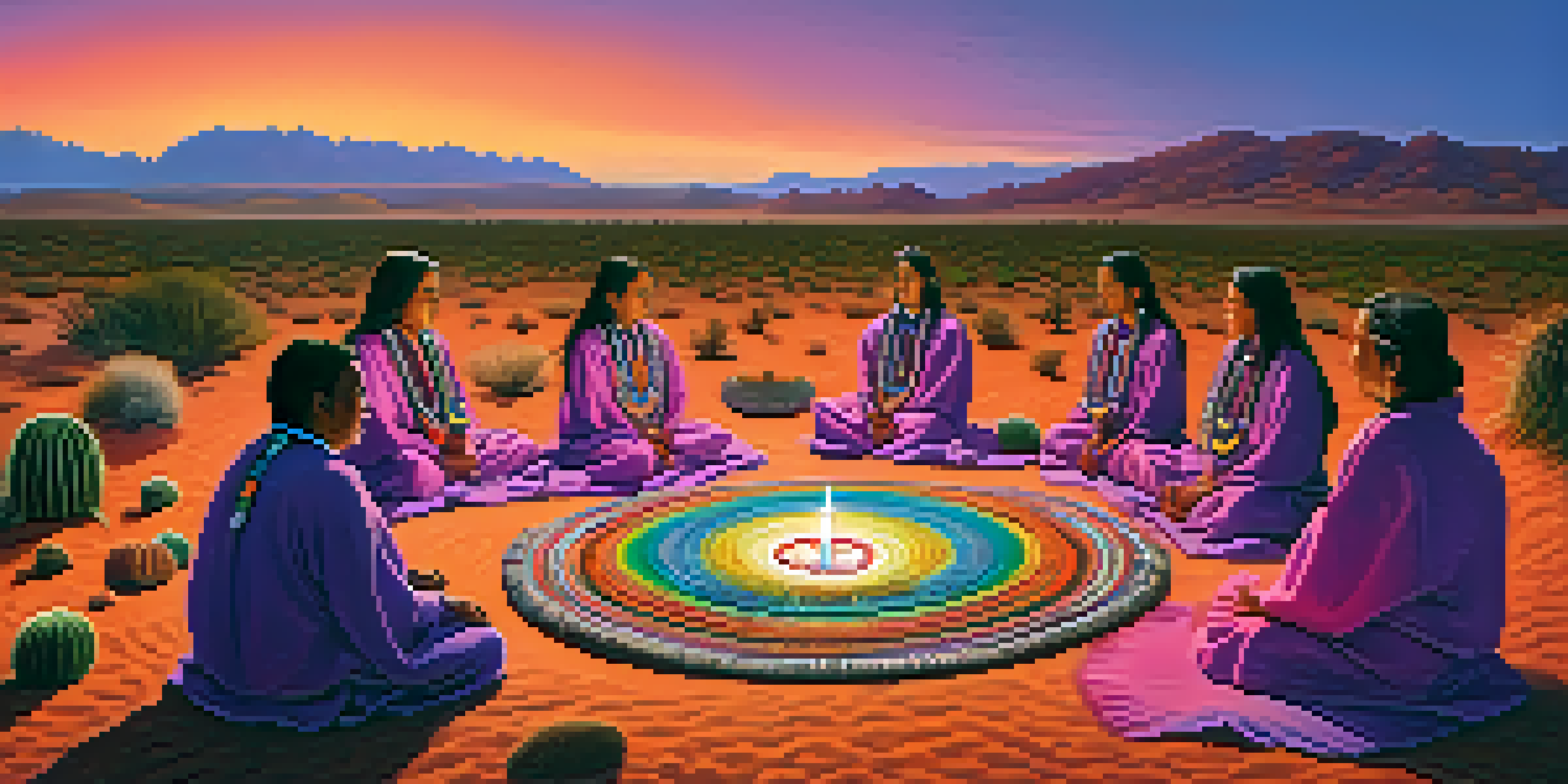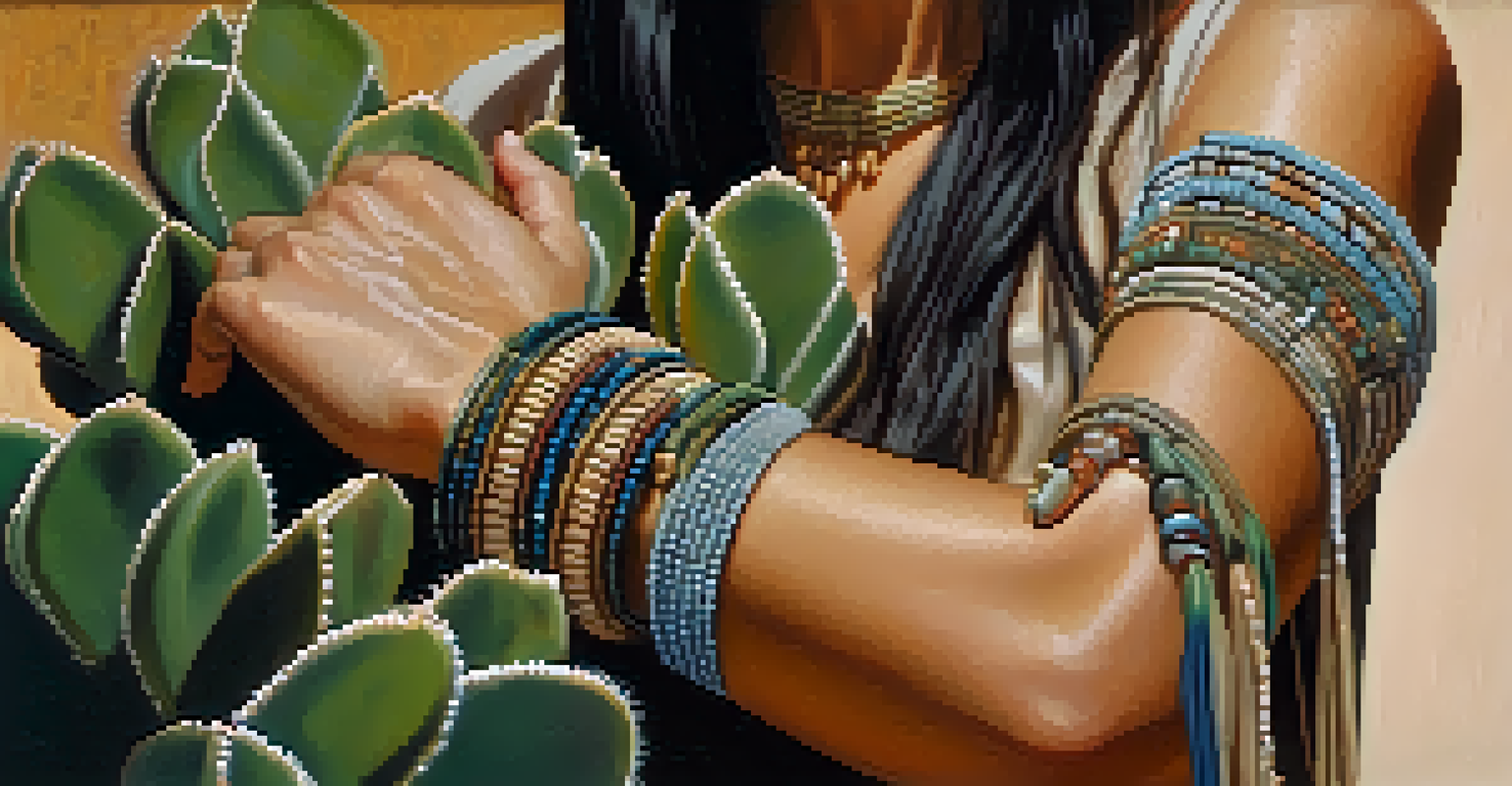Gender Dynamics in Peyote Ceremonies Across Indigenous Societies

Understanding Peyote and Its Cultural Significance
Peyote, a small cactus containing the psychoactive compound mescaline, holds profound spiritual significance for many Indigenous peoples, particularly in North America. It is often used in ceremonial contexts to facilitate healing, vision quests, and connection to the divine. The use of peyote is deeply embedded in the cultural practices and traditions of tribes such as the Huichol, Navajo, and Lakota, making it a vital aspect of their identity.
The spirit of peyote is a gift from the Earth, a sacred teacher that helps us remember who we are.
These ceremonies typically involve communal gatherings where participants consume peyote in a sacred setting. The experience is often described as a journey that fosters personal introspection and communal bonding. Understanding this context is crucial for exploring the intricate gender dynamics that emerge within these spiritual practices.
As we delve deeper into the ceremonies, it becomes clear that gender roles can significantly influence the structure and conduct of peyote rituals. This sets the stage for examining how different Indigenous societies navigate these dynamics, highlighting the interplay of tradition and evolving social roles.
Historical Context of Gender Roles in Indigenous Societies
Historically, many Indigenous societies have maintained distinct gender roles, which influence various aspects of life, including spirituality. Men and women often have specific responsibilities, with men typically taking on roles as leaders and spiritual guides in ceremonies. However, this division isn't absolute; many Indigenous cultures recognize the importance of women's contributions to spiritual practices, challenging the notion of fixed roles.

For instance, in some tribes, women are revered as keepers of tradition, responsible for passing down knowledge and conducting rituals. This recognition of women's roles highlights a more nuanced understanding of gender dynamics, revealing that while roles may differ, both men and women are integral to the spiritual fabric of their communities.
Peyote's Spiritual Role in Culture
Peyote serves as a vital spiritual tool for Indigenous peoples, fostering healing and connection during ceremonial practices.
As we explore these historical contexts, it becomes evident that gender dynamics are not static but are influenced by both tradition and contemporary societal changes. This backdrop is essential for understanding how peyote ceremonies adapt and evolve in response to shifting gender perceptions.
The Role of Men in Peyote Ceremonies
In many Indigenous cultures, men often play a central role in peyote ceremonies, serving as leaders or shamans. These figures are typically responsible for guiding participants through the spiritual experience, interpreting visions, and facilitating the healing process. This leadership role is often tied to broader cultural expectations of masculinity and authority within the community.
In Indigenous cultures, the balance of gender roles is essential for the health of the community and the sanctity of spiritual practices.
Men's roles can also include organizing the ceremony and preparing the peyote, which highlights their active participation in the ritualistic aspects. However, this does not imply that men's contributions are solely dominant; rather, they exist within a framework that acknowledges the significance of women's roles.
The dynamics between male leaders and female participants can lead to a rich tapestry of spiritual interaction, where both genders influence the ceremony's outcome. Understanding these roles helps clarify the complexities of gender dynamics in peyote ceremonies, illustrating a collaborative effort rather than a hierarchical structure.
Women's Influence and Participation in Peyote Ceremonies
Women have historically played a crucial role in peyote ceremonies, often serving as healers, caretakers, and spiritual guides. Their participation is vital, as women are frequently seen as the keepers of family and community wisdom, bringing a unique perspective to the ceremonial experience. This involvement serves to balance the male-dominated aspects of the rituals.
In many cases, women lead specific ceremonies that focus on healing and connection, showcasing their leadership abilities and deep spiritual insight. Their roles may vary from tribe to tribe, but the recognition of women's contributions is a common thread that reflects the diverse gender dynamics present in these practices.
Evolving Gender Dynamics in Ceremonies
Gender roles within peyote ceremonies are shifting, with increasing recognition of women's contributions and leadership.
Moreover, the increasing visibility of women in peyote ceremonies is reshaping traditional practices, allowing for a more egalitarian approach. As gender roles continue to evolve, the intersection of spirituality and gender becomes increasingly relevant, prompting a reevaluation of how these ceremonies are conducted.
Contemporary Changes in Gender Dynamics
In recent years, there has been a notable shift in the gender dynamics of peyote ceremonies, influenced by broader societal changes and movements for gender equality. Many Indigenous communities are reexamining traditional roles and embracing a more inclusive approach to spirituality. This evolution reflects a growing recognition of the diverse contributions of both men and women.
For instance, women are increasingly taking on leadership roles in ceremonies, challenging historical norms and asserting their place within the spiritual community. This shift is often accompanied by a resurgence of interest in women's stories and experiences, enriching the ceremonial narrative.
Additionally, younger generations are playing a pivotal role in redefining these dynamics, often advocating for a more balanced representation of gender. As these contemporary changes unfold, they not only impact the structure of peyote ceremonies but also foster a greater sense of unity and collaboration among participants.
Challenges and Tensions in Gender Dynamics
Despite the positive shifts in gender dynamics within peyote ceremonies, challenges and tensions persist. Resistance to change can stem from deeply ingrained cultural beliefs and practices that prioritize male leadership. This resistance can create friction between traditionalists and those advocating for more inclusive practices.
Moreover, the intersection of cultural identity and gender can complicate discussions around roles in peyote ceremonies. For many, preserving traditions is essential to maintaining cultural heritage, but it can also lead to conflicts over how best to honor these traditions while adapting to contemporary values.
Challenges in Gender Inclusivity
Despite progress, tensions remain as traditional beliefs sometimes clash with the push for more inclusive gender dynamics in ceremonies.
As communities navigate these complexities, open dialogue becomes crucial. By fostering conversations around gender dynamics, Indigenous societies can work towards creating a more inclusive environment that honors both tradition and the evolving roles of its members.
The Future of Gender Dynamics in Peyote Ceremonies
Looking ahead, the future of gender dynamics in peyote ceremonies appears to be one of growth and transformation. As more voices advocate for equality and representation, there is potential for a more balanced approach to spiritual practices. This evolution can enrich the ceremonial experience, allowing for diverse perspectives to flourish.
Engaging younger generations in these conversations is vital, as they often bring fresh ideas and a willingness to challenge outdated norms. Their involvement can help bridge the gap between tradition and modernity, ensuring that peyote ceremonies remain relevant and resonant for future participants.

Ultimately, the ongoing dialogue about gender roles within peyote ceremonies can lead to a deeper understanding of spirituality that honors both men and women. By embracing these changes, Indigenous societies can cultivate a more harmonious and inclusive environment, ensuring the sustainability of their cultural practices for generations to come.